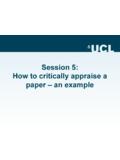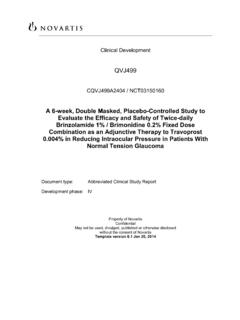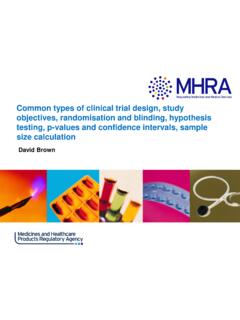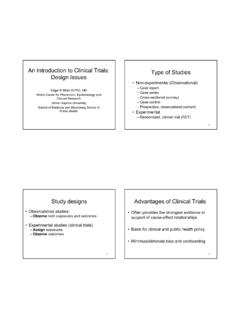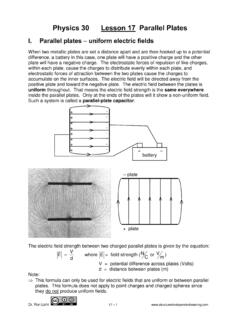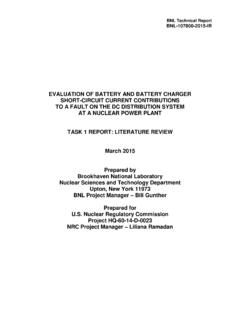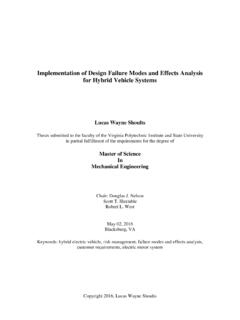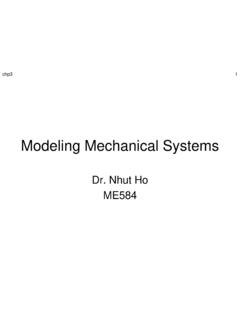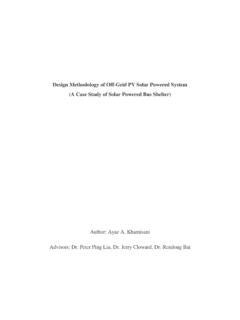Transcription of Cross-Sectional Study Design and Data Analysis
1 Cross-Sectional Study Design and data AnalysisChris OlsenMathematics DepartmentGeorge Washington High SchoolCedar Rapids, IowaandDiane Marie M. St. GeorgeMaster s Programs in Public HealthWalden UniversityChicago, IllinoisThe Young Epidemiology Scholars Program (YES) is supported byThe Robert Wood Johnson Foundation and administered by the College Plan ..3 Section I: Introduction to the Cross-Sectional Study ..7 Section II: Overview of Questionnaire Design ..9 Section III: Question Construction ..10 Section IV: Sampling ..16 Section V: Questionnaire Administration ..18 Section VI: Secondary Analysis of data ..19 Section VII: Using Epi Infoto Analyze YRBS data ..22 Worked Example for Teachers ..27 Assessment ..35 Appendix 1: YRBS 2001 data Documentation/Codebook ..43 Appendix 2: Interpreting Chi-Square A Quick Guide for Teachers.
2 50 Cross-Sectional Study Design and data Analysis2 Copyright 2004. All rights 2004 by College Entrance Examination Board. All rights Board and the acorn logo are registered trademarks of the College EntranceExamination Board. Microsoft Word, Microsoft Excel and Windows are registeredtrademarks of Microsoft Corporation. Other products and services may be trademarksof their respective owners. Visit College Board on the Web: PlanTITLE: Cross-Sectional Study Design and data AnalysisSUBJECT AREA:Statistics, mathematics, biologyOBJECTIVES:At the end of this module, students will be able to: Explain the Cross-Sectional Study Design Understand the process of questionnaire construction Identify several sampling strategies Analyze and interpret data using Epi Infostatistical softwareTIME FRAME:Two class periods and out-of-class group timePREREQUISITE KNOWLEDGE:Advanced biology; second-year algebra level of mathematical NEEDED: Epi Infosoftware (freeware downloadable from the Internet).
3 High-speed Internet connection is useful. Youth Risk Behavior Survey (YRBS) sample datasets (student and teacher versions accompa-nying this module). Abbreviated YRBS Codebook (included as an appendix to the module).Please note that teachers are notrequired or expected to download the entire YRBS datasetor the YRBS Codebook. Those files have already been downloaded and formatted for use withthe module, and we would recommend that teachers make use of them. However, if teachersshould choose to download the YRBS dataset from the Web site, please be advised that thedataset will not be in Epi Infoformat and will require manipulation in order to be used withthe Epi :Teachers should ask the students to read Sections I V at home, and then in classthe teacher should review the major concepts contained therein.
4 The teachershould cover Section VI during the class period, using the worked example as aguide as needed. The groups should then assemble and begin to work together inclass on the group project. This allows them to have teacher input while Design -ing their research questions and beginning to learn the software. They shouldthen complete the group projects as Study Design and data AnalysisCopyright 2004. All rights :At end of module. There are four options provided, one of which includes suggested TO STANDARDS: This module addresses the following mathematics standards:4 Cross-Sectional Study Design and data AnalysisCopyright 2004. All rights StandardThe Grades 9 12 Expectations Use simulations to explore the variability of samplestatistics from a known population and to constructsampling distributions; understand how sample statis-tics reflect the values of population parameters and Develop and evaluate inferencesand predictions that are basedon data .
5 For univariate measurement data , be able to displaythe distribution, describe its shape, and select and cal-culate summary statistics; for bivariate measurementdata, be able to display a scatter plot, describe itsshape, and determine regression coefficients, regres-sion equations, and correlation coefficients using tech-nological tools; display and discuss bivariate datawhere at least one variable is categorical; recognizehow linear transformations of univariate data affectshape, center and spread; identify trends in bivariatedata and find functions that model the data or trans-form the data so that they can be modeled. Select and use appropriate sta-tistical methods to analyze data . Understand the differences among various kinds ofstudies and which types of inferences can legitimatelybe drawn from each; know the characteristics of well-designed studies, including the role of randomizationin surveys and experiments; understand the meaning ofmeasurement data and categorical data , of univariateand bivariate data , and of the term variable; under-stand histograms, parallel box plots, and scatter plotsand use them to display data ; compute basic statisticsand understand the distinction between a statistic anda parameter.
6 Formulate questions that can beaddressed with data and collect,organize and display relevantdata to answer Analysis and ProbabilityInstructional programs fromprekindergarten through grade 12 should enable all students to:5 Cross-Sectional Study Design and data AnalysisCopyright 2004. All rights SolvingInstructional programs from prekindergarten through grade 12 should enable all students to: Build new mathematical knowledge through problem solving Solve problems that arise in mathematics and in other contexts Apply and adapt a variety of appropriate strategies to solve problems Monitor and reflect on the process of mathematical problem solvingCommunicationInstructional programs from prekindergarten through grade 12 should enable all students to: Organize and consolidate their mathematical thinking through communication Communicate their mathematical thinking coherently and clearly to peers, teachers, and others Analyze and evaluate the mathematical thinking and strategies of others Use the language of mathematics to express mathematical ideas preciselyConnectionsInstructional programs from prekindergarten through grade 12 should enable all students to: Recognize and use connections among mathematical ideas Understand the concepts of sample space and proba-bility distribution and construct sample spaces anddistributions in simple cases; use simulations to construct empirical probability distributions; computeand interpret the expected value of random variablesin simple cases.
7 Understand the concepts of condi-tional probability and independent events; understandhow to compute the probability of a compound event. Understand and apply basic concepts of sampling distributions as the basis for informalinference; evaluate published reports that are based ondata by examining the Design of the Study , the appro-priateness of the data Analysis , and the validity of con-clusions; understand how basic statistical techniquesare used to monitor process characteristics in theworkplace. Understand how mathematical ideas interconnect and build on one another to produce acoherent whole Recognize and apply mathematics in contexts outside of mathematicsRepresentationInstructional programs from prekindergarten through grade 12 should enable all students to: Create and use representations to organize, record, and communicate mathematical ideas Select, apply and translate among mathematical representations to solve problems Use representations to model and interpret physical, social, and mathematical phenomenaThis module also addresses the following science standards:Science As Inquiry Abilities necessary to do scientific inquiryUnifying Concepts and Processes Evidence, models and explanationBibliographyAday L.
8 Designing & Conducting Health ed. San Francisco: Jossey-Bass Publishers; , P. P., & Lyberg, L. E. Introduction to Survey , NJ: John Wiley for Disease Control and Prevention. 2001 Youth Risk Behavior Survey Results, United States High SchoolSurvey Codebook. Available at: J, Presser S. Survey Questions: Handcrafting the Standardized Questionnaire. Thousand Oaks, CA: SagePublications; F. Improving Survey Questions: Design and Evaluation. Thousand Oaks, CA: Sage Publications; H, Presser S. Questions & Answers in Attitude Surveys: Experiments on Question Form, Wording, and Oaks, CA: Sage Publications; S, Bradburn N. Asking Questions: A Practical Guide to Questionnaire Design . San Francisco: Jossey-BassPublishers; S, Bradburn N, Schwarz N. Thinking about Answers: The Application of Cognitive Processes to SurveyMethodology.
9 San Francisco: Jossey-Bass Publishers; R, Rips L, Rasinski K. The Psychology of Survey Response. New York: Cambridge University Press; Study Design and data AnalysisCopyright 2004. All rights I: Introduction to the Cross-Sectional StudyEpidemiologists are public health researchers. Some of the most popular examples of epidemiolo-gy in action are related to research surrounding the causes of infectious disease outbreaks andepidemics. When we first began to hear about SARS (severe acute respiratory syndrome) in late2002, the unsung heroes were those epidemiologists attempting to determine what caused theoutbreak. Similarly, about 20 years ago when AIDS (acquired immunodeficiency syndrome) wasfirst identified, albeit not by this name, epidemiologists were busy at work collaborating withbasic scientists to attempt to determine what was causing the disease.
10 However, epidemiologists are also behind the scenes, acting as medical and health detectivesand conducting research to determine causes of chronic diseases as well. Through epidemiologicstudies, we learned that smoking causes lung cancer, that high-fat diets contribute to the devel-opment of heart disease and that fluoridation of water can reduce the occurrence of dental tools or research Study designs used by epidemiologists are varied. However, there is athought process or reasoning they use that is consistent throughout: If a factor X causes a dis-ease Y, then there will be proportionately more diseased people among the group with X thanamong the group that does not have X. Think about it this way: If it were true that shavingcaused one's hair to grow back thicker, would you expect to find thicker hair among your class-mates who shaved or among your classmates who did not shave?
